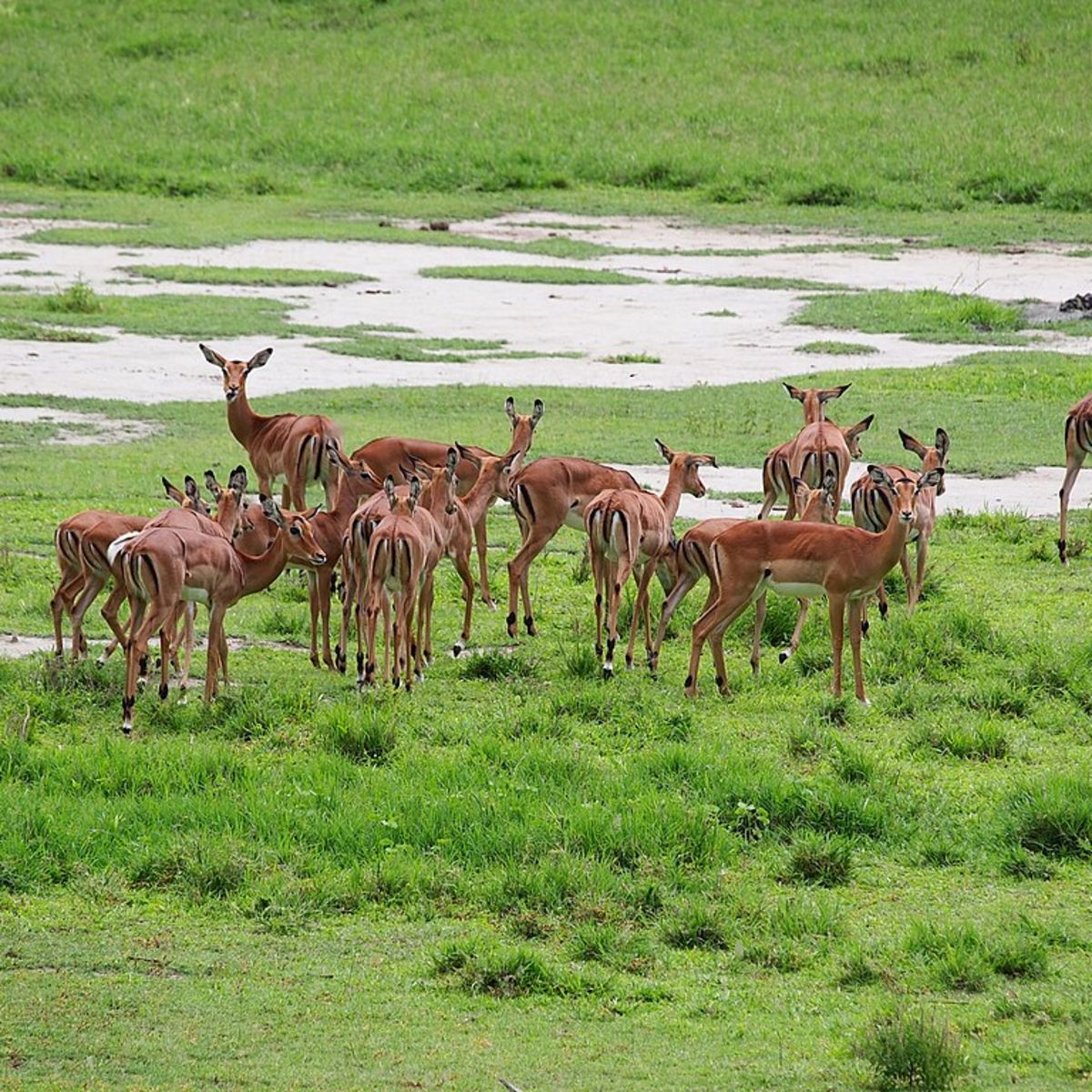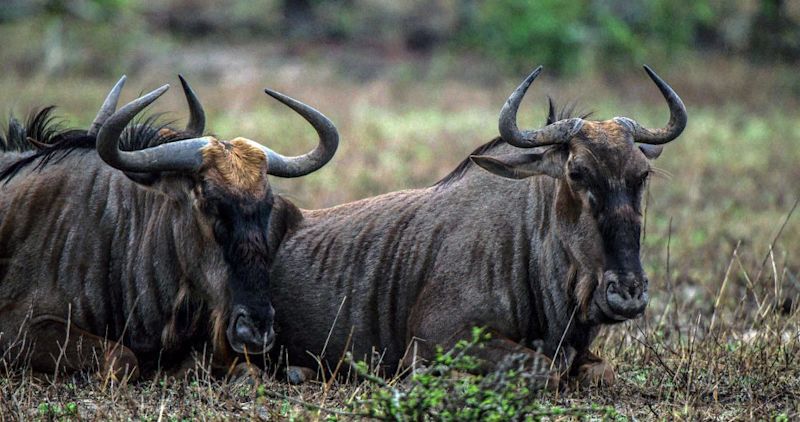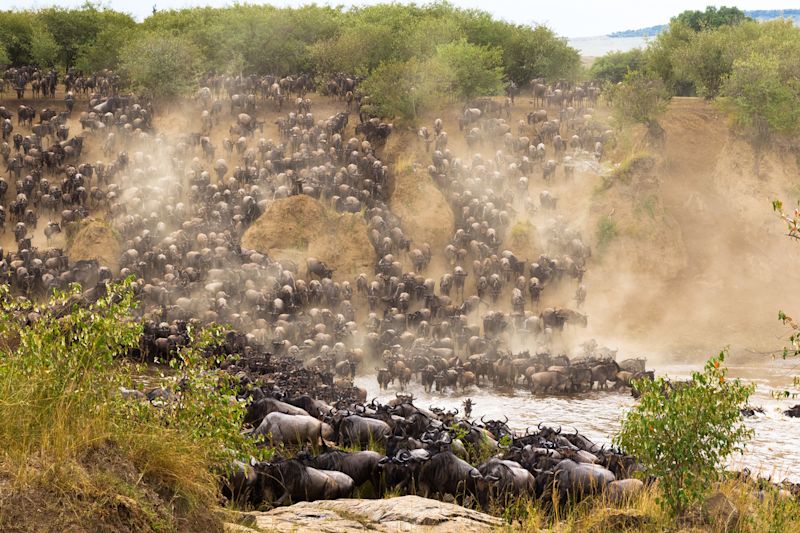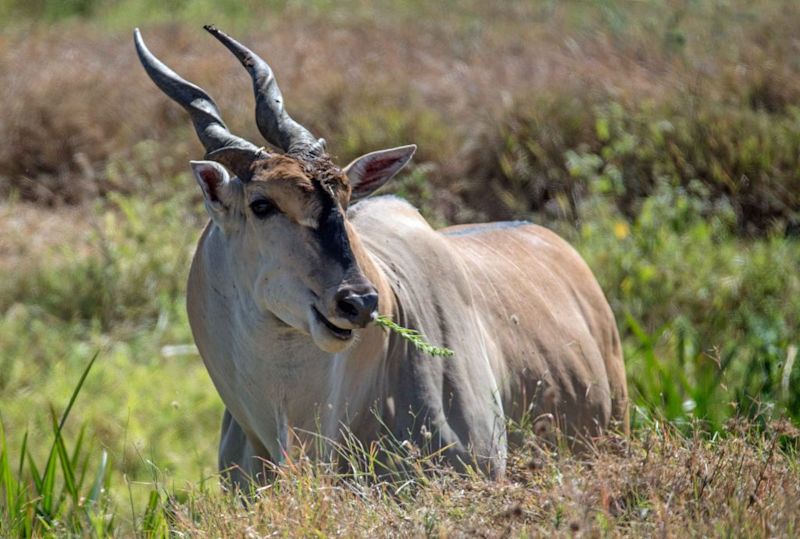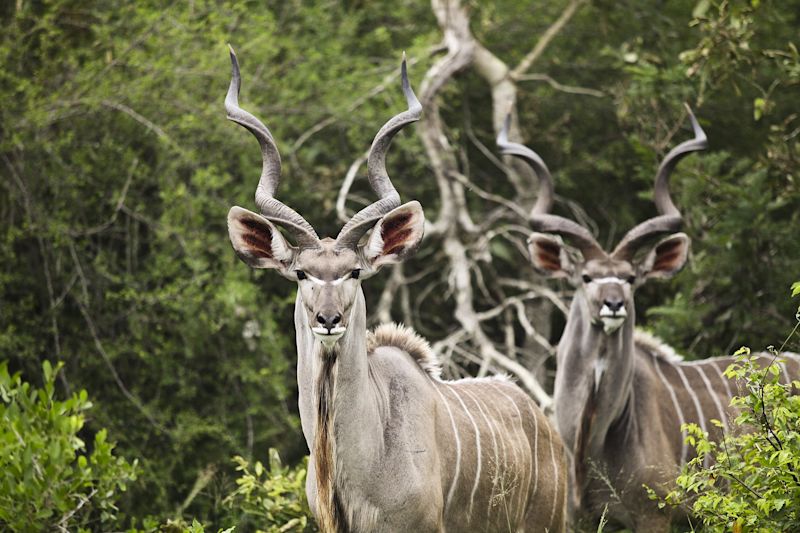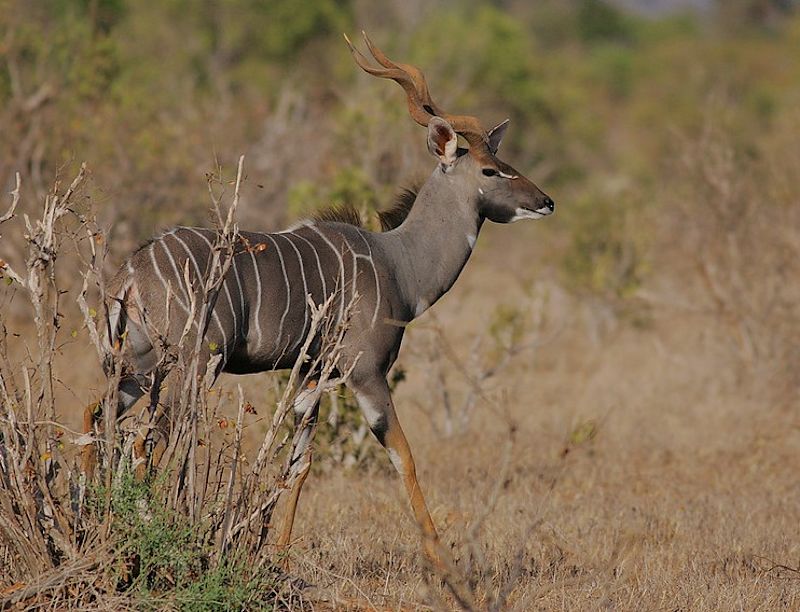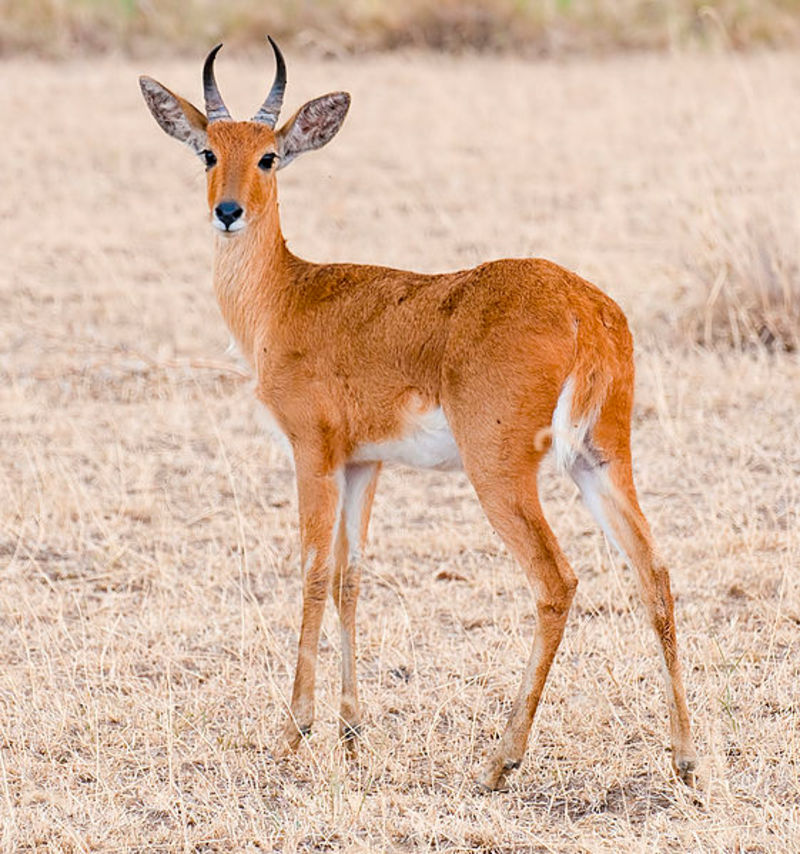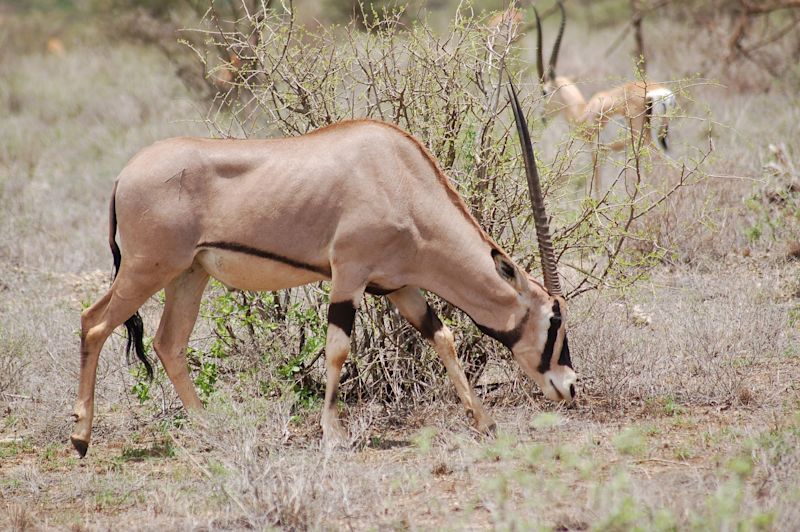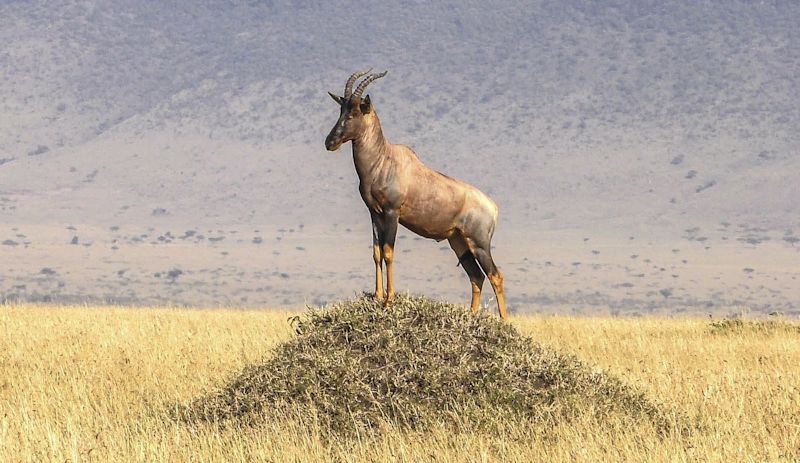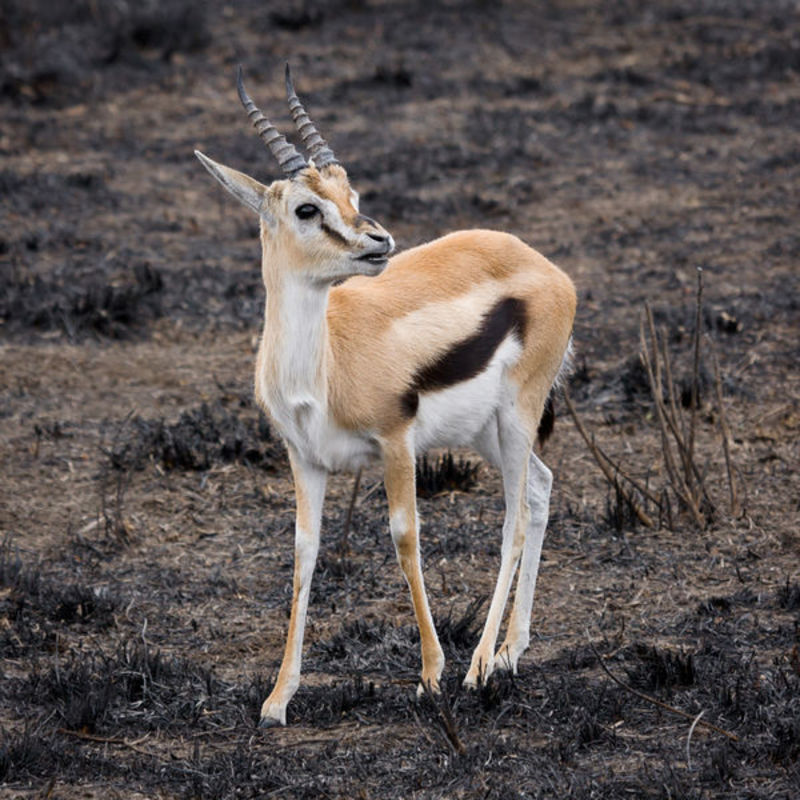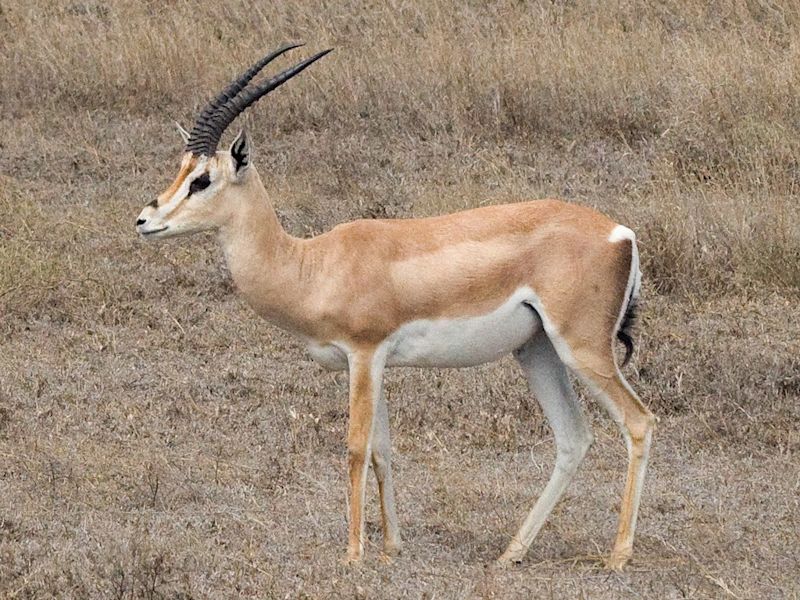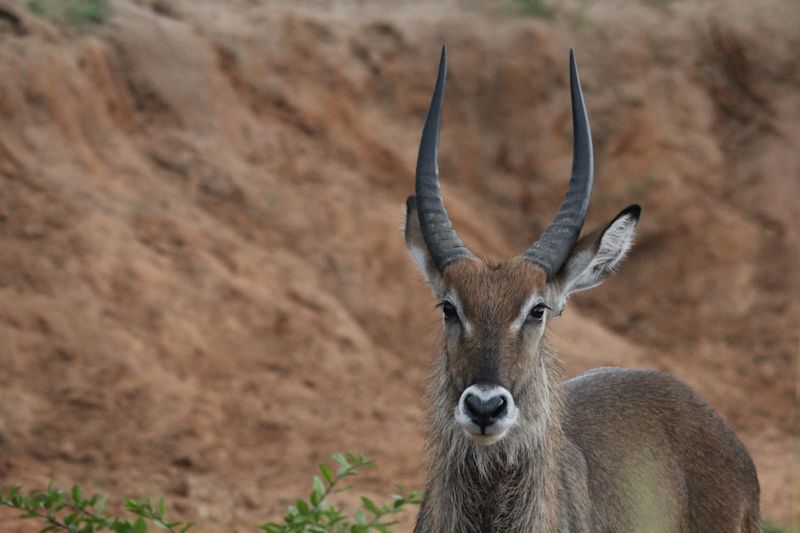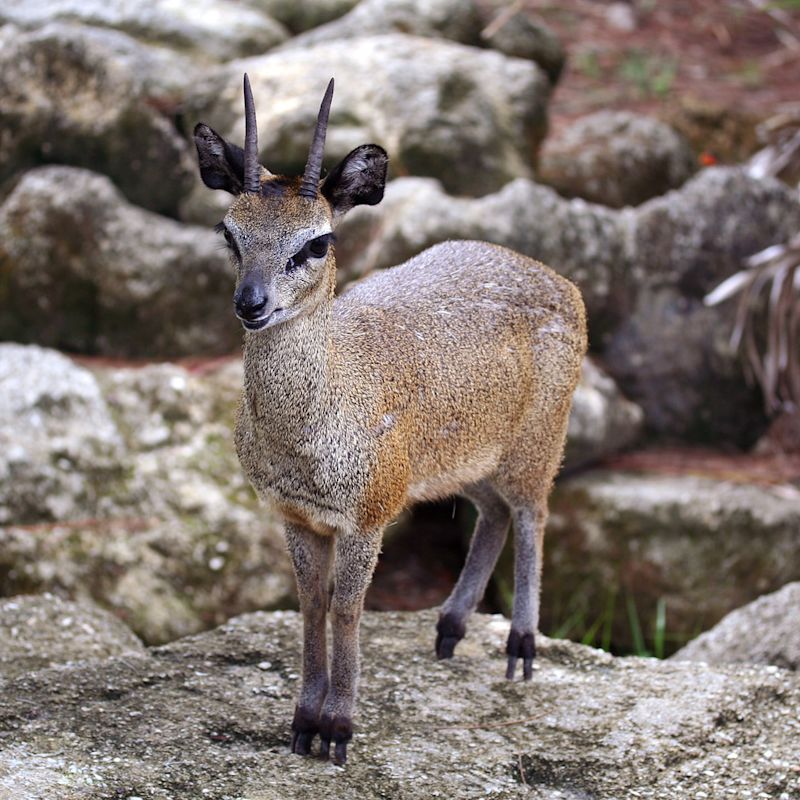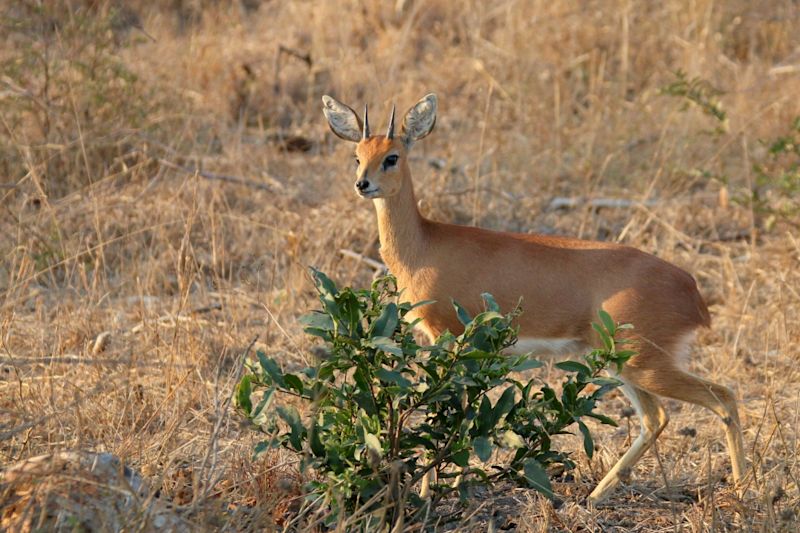1. Blue wildebeest
There are around 1.5 million blue wildebeests in the Serengeti!
The blue wildebeest has a string of interchangeable names: blue wildebeest, common wildebeest, white-bearded wildebeest, white-bearded gnu, or brindled gnu. So simply pick the one that works for you!
Blue wildebeests are not, as you can see above, blue. Although sometimes there's a blue tinge to their pelage (coat).
They're herbivores and eat grass. They have a long mane on the ridge of their backs, and narrow faces. Both sexes have curved horns, but you can identify the bulls (males) in the group as they're bigger and darker.
The star of the Great Migration
Wildebeests crossing a river in the Serengeti
The blue wildebeest is a core component of a Serengeti safari, as it's the star of The Great Wildlife Migration. Over 1.5 million wildebeests take part in this never-ending migration through the territory of the Serengeti, accompanied by over a million zebras, elands, impalas and gazelles. The Great Migration is the largest land-based migration in the world and a spectacle like no other!
If you'd like to know some further interesting facts about wildebeests, like why they rely on zebras for their survival, please read 7 truly stupendous facts about the Great Migration.
2. Southern eland
The eland is the world's largest antelope
Elands are enormous antelopes. Adult bulls can weigh up to 940 kg (2,070 lb)! Oomph.
Their spiral horns and dewlaps are two helpfully distinguishing markers.
The elands you find in Serengeti National Park are southern elands (taurotragus oryx), also called common elands or eland antelopes. Many of you might not know that they produce very rich milk and have tasty meat, so they're actually farmed in some parts of Africa.
3. Greater kudu
There's something distinctly regal about kudus
The greater kudu (tragelaphus strepsiceros) is a large antelope with very large ears and distinctive white stripes running in parallel down its flanks. It also has a thin white line connecting the eyes, which is a very helpful identification marker.
A horny story
Bull greater kudus have long, beautiful horns with large twists in them. The horns grow a twist every two years, and two and a half twists are the maximum.
If stretched out, the horns of a greater kudu can reach 1.8 metres!
Sometimes, but not always, the females (cows) grow short horns too.
This female kudu has small horns – but not all cows grow them
4. Lesser kudu
A lesser kudu as captured by S. Garvie
The lesser kudu (tragelaphus imberbis) is a shy animal that lives mostly in thick vegetation. And it has a very limited range in East Africa. So spotting one is a feat worthy of some social media bragging. The white under the tail is what you're most likely to spot, as this sometimes provides a flash of colour among the concealing foliage.
Bulls have spiralled horns and are darker brown on the torso, while cows have no horns and have a more reddish-brown torso. Both sexes have a long stripe down the spine and roughly perpendicular stripes running down from it on either side. The legs and horns have an orange tinge to them, which can help you to differentiate them from greater kudus. Lesser kudus are also much smaller than greater kudus.
Note that you're more likely to spot a lesser kudu at Tarangire National Park than in the Serengeti. Tarangire is also a great place for finding greater kudus.
To avoid getting their horns stuck in vegetation, the males tilt their heads back so that their horns lay along their backs, and then walk forward in this posture!
5. Bohor reedbuck
A great pic of a ram Bohor reedbuck in Serengeti by Y. Krishnappa
The Bohor reedbuck (redunca redunca) is a long-limbed, medium-sized antelope that can be found in quite a few places in Tanzania, always near water. You have a good chance of spotting some of these delightful antelopes in the Serengeti.
When a bohor reedbuck whistles (which it does to mark its territory), the air comes out of the nose with such force that the whole body vibrates!
Only the rams (males) have horns. They also have stouter necks and builds in general than the ewes (females).
6. Fringe-eared oryx
As much as 80% of a fringe-eared oryx's diet is grass
Fringe-eared oryxes can only be found in NE Tanzania and SE Kenya.
The type of oryx that you find in the Serengeti is the subspecies known as the fringe-eared oryx (oryx beisa callotis). (Although some argue that it should be classified as its own species.)
As you can see above, it has extremely long, straight, ringed horns, making it easy to recognise. It's fawn in colour with some helpful black stripes and bands, as well as patches of white on the face. Bulls and cows look the same to the casual observer.
7. Coke's hartebeest
Coke's hartebeests have horns that sweep outwards from the centre
There's no easy way to say this: the hartebeest isn't the prettiest of creations. Though like most of us, a good bathing in angled sunlight does it wonders.
All hartebeests have an elongated face and a downward-sloping back. But probably the most noticeably distinguishing aspect of the Coke's hartebeest is its wide-swept horns (other subspecies have more parallel horns). Cows also have horns, they're just more slender.
Coke's hartebeest (alcelaphus buselaphus cokii), also called the kongoni, lives only in northeastern Tanzania and two pockets in Kenya. So it's a rare subspecies that you'll be looking for on your Serengeti safari.
8. Topi
This topi knows how to pose for a camera
The topi (or nyamera) looks similar to the hartebeest, the reason being that they belong to the same subfamily. As you can see, both topis and hartebeests have short necks, long faces and long legs. Topis are very social, and very fast.
The Serengeti is the primary ecosystem for topis.
The most noticeable difference between the hartebeest and the topi (damaliscus lunatus jimela) is the darker colouring of the latter, particularly on the upper legs.
9. Thomson's gazelle
A Serengeti Thomson's gazelle photographed by Ikiwaner
The Thomson's gazelle (eudorcas thomsonii) is relatively easy to identify given it has a lateral black stripe on either side of the torso.
If you find Thomson's gazelle too much of a mouthful, you can just refer to them as tommies.
The Serengeti subspecies
There are two subspecies of Thomson's gazelle: the eastern Thomson's gazelle and the Serengeti Thomson's gazelle. No points for guessing which you'll see on a Serengeti safari. The Serengeti Thomson's gazelle has a whiter face than the eastern variety, and it has a well-defined black stripe running from the inner eye towards the mouth.
There are around half a million gazelles in Serengeti National Park. This population is a mix of Thomson's and Grant's gazelles.
10. Grant's gazelle
A ram Grant's gazelle
The Grant's gazelle (nanger granti or gazella granti) is a beautiful creature. Inhabitants of East Africa, these gregarious herbivores live in herds ranging from 20 to 200 members.
The Grant's gazelle can raise its body temperature when it's hot to sweat less and so conserve water.
Grant's gazelles can go long periods without water, which allows them to migrate to areas where more water-dependent grazers fear to tread.
They're similar to Thomson's gazelles, but most notably don't have the black stripes on their sides and are bigger. They also have a slightly longer lifespan than Tommies, living around 12 years in the wild.
These lovely antelopes are populous in the Serengeti, and also take part in the Great Migration, so you have every reason to hope to see some herds while on safari there. 🙂
11. Common waterbuck
Waterbucks have shaggy necks
Like its name suggests, the waterbuck (kobus ellipsiprymnus) needs to stay close to water to avoid dehydration. It also needs grass for grazing. So it has specific zones where it lives, and your Serengeti driver will know the sections in the park to take you to spot this antelope.
The subspecies you'll be seeing in the Serengeti is the common waterbuck.
Common waterbucks are easy to identify as they have long and shaggy hair on the neck. They also have a white ring on the rump. Bulls have long, sweeping, faintly ringed horns.
12. Imbabala bushbuck
A ram bushbuck
The bushbuck is the smallest of the spiral-horned antelopes and has an average lifespan of 12 years. It's the only African antelope where the rams are solitary and non-territorial. Even the ewes don't like to be around other bushbuck, including their young, for the entire day.
The bushbuck is sexually dimorphic. This means rams and ewes have lots of physical differences. The most obvious is the absence of horns on ewes (though on rare occasions ewes have horns too). The rams are also bigger and heavier, with dark grey pelage (fur). Ewes have a reddish-brown pelage. And they have more noticeable white spots and patches on the ears, chin, neck, legs and tail.
An ewe Cape bushbuck as photographed by C. Sharp
Imbabala bushbuck (tragelephus sylvaticus) is the bushbuck species that you'll be looking for in the Serengeti.
FYI, the two sexes of very large antelopes are referred to as bulls and cows, while in mid-sized and smaller antelopes they're usually referred to as rams and ewes.
13. Klipspringer
A ram klipspringer – these guys are very small
The klipspringer (oreotragus oreotragus) is a darling antelope, sure to be on the wish list of any safari-goer with a penchant for sweet and little things. But being nocturnal and liking rocky, mountainous terrain, it's unlikely you'll spot one. Unless ... challenge accepted?
Klipspringers mate for life. Each pair has its own territory, and one will act as sentry while the other browses.
Klipspringers generally only weigh 8 to 18 kg (18 to 40 lb). The insides of the ears are prettily two-tone. Each hoof, as you can see above if you zoom in, consists of two cylinder-like parts, and they walk on the tips. This makes them agile when navigating their rocky habitat.
14. Steenbok
The male steenbok has short, sharp horns
The steenbok (raphicerus campestris), also called steinbuck or steinbok, is a small antelope with an orange-tinged fawn coat, a white underside, and large ears. Rams have short, straight horns with menacingly sharp points.
Steenboks eat low-level vegetation as well as roots and tubers, and get almost all of their required moisture from their diet.
Steenboks aren't easy to spot, as they can roam far from water sources and are small in stature. During the hottest parts of the day, they're most likely to be found resting in shady spots.
To escape predators (of which there are many), steenboks will flee in a zigzag pattern as well as lay low in vegetation. If the opportunity presents itself, they've even been known to seek refuge in the burrows of aardvarks!
15. Dik-dik
Dik-diks are one of the smallest antelopes
Dik-diks are dainty antelopes. In fact, they're the second smallest antelope after West Africa's royal antelope.
They're pretty sedentary creatures, and fairly solitary as well. They live mostly in bushy scrub and by kopjes. They can run as fast as 42 km per hour, which helps them to escape predators.
Interestingly, female dik-diks are larger than the males of the species. And like penguins, dik-diks bond with a single mate for life.
The species of this little antelope that you can find in the Serengeti is called Naivasha dik-dik (madoqua cavandishi). Ugogo dik-diks can also venture into this territory.
16. Common impala
A juvenile common impala and a red-billed oxpecker
You often see oxpeckers perched on impalas as they eat their fleas, ticks and lice. It's all part of a healthy relationship called mutualism.
The impala (Aepyceros melampus) is a graceful, mid-sized antelope similar in appearance to the gazelle and oribi.
Ram impalas have long, ringed, lyre-shaped horns, while ewes have no horns. Ewes are also slightly smaller, but other than that the two sexes look pretty similar.
Impalas have a distinct strategy for evading predators that includes two leaps. They're also fast runners. We particularly love their long and powerful leaps.
17. Oribi
This lovely pic of a seated ram oribi was taken by B. Dupont
The oribi (Ourebia ourebi) is a small, slender antelope with a reddish-brown pelage. It's similar to the steenbok in appearance, but is larger.
Ram oribis have short, sharp, straight horns, while the ewes have none. Like many other antelopes, ewe oribis have four teats.
Oribis keep newborns hidden for a month, and the mother returns at intervals to suckle it.
18. Gerenuk
Gerenuks are easy to identify because of their long, thin necks | Image by V. Storti
The gerenuk (Litocranius walleri) is a surprising-looking antelope; its long neck puts you in mind of the giraffe. And in fact, the word gerenuk is Somali for giraffe-necked.
This spindly creature with the big eyes and ears is part of the gazelle family. It can only be found in Tanzania, Kenya, southern Somalia, Ethiopia and Eritrea.
Ram gerenuks have fairly short, curved horns, while the ewes have none. The male gerenuk has a noticeably thicker neck.
19. Common duiker
This fabulous shot of a ram duiker was taken by A. Meintjes
The common (or grey) duiker (sylvicapra grimmia) – one of the prettiest duikers, for sure – stands around 50 cm at shoulder height. The rams have horns that average just 11 cm in length. Apart from its diminutive size, its dark face markings make it easy to identify.
Common duikers can be spotted in the Serengeti, but not often. And it doesn't help that duikers are nocturnal. So you've got your work cut out for you ticking it off your sightseeing list.
What is helpful, however, is that common duikers can be found in many, many parts of sub-Saharan Africa, so if you go on safari often, your chances of seeing one increases greatly.
Which do you most want to see?
So now that you know all of the antelopes you can hopefully spot on a Serengeti safari, we're curious: which would you most like to see? We'd love to hear your answer!
